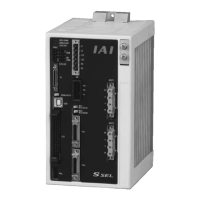181
Part 2 Programs
JW (Jog)
Command, declaration
Extension condition
(LD, A, O, AB, OB)
Input condition
(I/O, flag)
Command,
declaration
Operand 1 Operand 2
Output
(Output, flag)
Optional Optional JW
Axis
pattern
Input,
output, flag
number
PE
[Function] The axes in the axis pattern specified in operand 1 will move forward or backward while the
input or output port or flag specified in operand 2 is ON or OFF.
JBWF
Move backward while the specified port is OFF.
JBWN
Move backward while the specified port is ON.
JFWF
Move forward while the specified port is OFF.
JFWN
Move forward while the specified port is ON.
(Note 1) This command is also valid on an axis not yet completing home return. In this case, the
maximum speed will be limited by “All-axis parameter No. 15, Maximum jog speed before
home return.” Since coordinate values do not mean anything before home return, pay due
attention to prevent contact with the stroke ends.
(Note 2) If “Axis-specific parameter No. 1, Axis operation type” is set to “0” (Linear movement axis) and
“Axis-specific parameter No. 68, Mode selection for linear movement axis” is set to “1” (Infinite-
stroke mode*) for the axis moved with JW, the axis will operate in the infinite-stroke mode.
During infinite-stroke operation, the current position cycles between approx. -10 m and 10 m.
A positioning command other than the above where the coordinate range of approx. -9990 to
+9990 is exceeded will generate an “Error No. CBE, Target data boundary over error.”
Executing a positioning command other than the above where the coordinate range of approx.
-9990 to +9990 is exceeded will result in an “Error No. CC5, Positioning boundary pull-out
error.”
(These errors generate because the user cannot reliably recognize the operating direction
around the boundary. Use this command in combination with the setting of “1” (Current
position 0 home) in “Axis-specific parameter No. 10, Home-return method,” and reset the
current value using a HOME command, if necessary.)
During infinite-stroke operation, always perform timeout check using other task or from an
external system.
The infinite-stroke mode can be specified only when an incremental encoder is used.
If you wish to use the infinite-stroke mode, contact IAI’s Sales Engineering.
[Example 1] VEL 100 Set the speed to 100 mm/s.
JBWF 11 10 Move axes 1 and 2 backward while input 10 is OFF.
[Example 2]
The axis pattern can be specified indirectly using a variable.
When the command in [Example 1] is rephrased based on indirect specification using a
variable:
11 (binary) 3 (decimal)
VEL 100 Set the speed to 100 mm/s.
LET 1 3 Assign 3 to variable 1.
JBWF *1 10
[Example 3] VEL 100 Set the speed to 100 mm/s.
LET 5 20 Assign 20 to variable 5.
JFWN 10 *5 Move axis 2 forward while the content of variable 5 (input
20), is ON.

